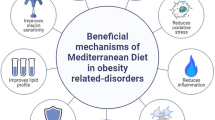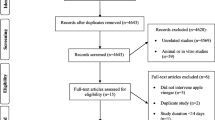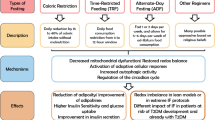Abstract
Purpose
To assess the effects of a pistachio-enriched diet on the profile of circulating microRNAs (miRNAs) related to glucose metabolism and insulin resistance (IR).
Methods
Randomized crossover clinical trial in 49 subjects with prediabetes was performed. Subjects consumed a pistachio-supplemented diet (PD, 50 % carbohydrates, 33 % fat, including 57 g/day of pistachios) and an isocaloric control diet (CD, 55 % carbohydrates and 30 % fat) for 4 months each, separated by a 2-week washout period. The plasma profile of a set of seven predefined miRNAs related to glucose and insulin metabolism was analyzed by quantitative RT-PCR.
Results
After the PD period, subjects have shown significant lower circulating levels of miR-192 and miR-375 compared to CD period, whereas miR-21 nonsignificantly increased after PD compared with CD (47 vs. 2 %, P = 0.092). Interestingly, changes in circulating miR-192 and miR-375 were positively correlated with plasma glucose, insulin and HOMA-IR.
Conclusion
Chronic pistachio consumption positively modulates the expression of some miRNA previously implicated on insulin sensitivity.



Similar content being viewed by others
References
Stumvoll M, Goldstein BJ, van Haeften TW (2010) Type 2 diabetes: principles of pathogenesis and therapy. Lancet 365:1333–1346. doi:10.1016/S0140-6736(05)61032-X
Perreault L, Færch K (2014) Approaching Pre-diabetes. J Diabetes Complicat 28:226–233. doi:10.1016/j.jdiacomp.2013.10.008
Creemers EE, Tijsen AJ, Pinto YM (2012) Circulating MicroRNAs: novel biomarkers and extracellular communicators in cardiovascular disease? Circ Res 110:483–495. doi:10.1161/CIRCRESAHA.111.247452
Honardoost M, Sarookhani MR, Arefian E, Soleimani M (2014) Insulin resistance associated genes and miRNAs. Appl Biochem Biotechnol 174:63–80. doi:10.1007/s12010-014-1014-z
Ambros V (2004) The functions of animal microRNAs. Nature 431:350–355. doi:10.1038/nature02871
Weber JA, Baxter DH, Zhang S et al (2010) The microRNA spectrum in 12 body fluids. Clin Chem 56:1733–1741. doi:10.1373/clinchem.2010.147405
Kosaka N, Iguchi H, Yoshioka Y et al (2010) Secretory mechanisms and intercellular transfer of microRNAs in living cells. J Biol Chem 285:17442–17452. doi:10.1074/jbc.M110.107821
Rottiers V, Näär AM (2012) MicroRNAs in metabolism and metabolic disorders. Nat Rev Mol Cell Biol 13:239–250. doi:10.1038/nrm3313
Chen X, Ba Y, Ma L et al (2008) Characterization of microRNAs in serum: a novel class of biomarkers for diagnosis of cancer and other diseases. Cell Res 18:997–1006. doi:10.1038/cr.2008.282
Ross SA, Davis CD (2014) The emerging role of microRNAs and nutrition in modulating health and disease. Annu Rev Nutr 34:305–336. doi:10.1146/annurev-nutr-071813-105729
Tomé-Carneiro J, Larrosa M, Yáñez-Gascón MJ et al (2013) One-year supplementation with a grape extract containing resveratrol modulates inflammatory-related microRNAs and cytokines expression in peripheral blood mononuclear cells of type 2 diabetes and hypertensive patients with coronary artery disease. Pharmacol Res 72:69–82. doi:10.1016/j.phrs.2013.03.011
Ortega FJ, Cardona-Alvarado MI, Mercader JM et al (2015) Circulating profiling reveals the effect of a polyunsaturated fatty acid-enriched diet on common microRNAs. J Nutr Biochem. doi:10.1016/j.jnutbio.2015.05.001
Hernández-Alonso P, Salas-Salvadó J, Baldrich-Mora M et al (2014) Beneficial effect of pistachio consumption on glucose metabolism, insulin resistance, inflammation, and related metabolic risk markers: a randomized clinical trial. Diabetes Care 37:3098–3105. doi:10.2337/dc14-1431
Roberts TC, Coenen-Stass AML, Wood MJA (2014) Assessment of RT-qPCR normalization strategies for accurate quantification of extracellular microRNAs in murine serum. PLoS One 9:e89237. doi:10.1371/journal.pone.0089237
Ortega FJ, Mercader JM, Moreno-Navarrete JM et al (2014) Profiling of circulating microRNAs reveals common microRNAs linked to type 2 diabetes that change with insulin sensitization. Diabetes Care 37:1375–1383. doi:10.2337/dc13-1847
Guay C, Regazzi R (2013) Circulating microRNAs as novel biomarkers for diabetes mellitus. Nat Rev Endocrinol 9:513–521. doi:10.1038/nrendo.2013.86
Chakraborty C, Doss C, Bandyopadhyay S, Agoramoorthy G (2014) Influence of miRNA in insulin signaling pathway and insulin resistance: micro-molecules with a major role in type-2 diabetes. Wiley Interdiscip Rev RNA 5(5):697–712. doi:10.1002/wrna.1240
Lu M, Zhang Q, Deng M et al (2008) An analysis of human microRNA and disease associations. PLoS One 3:e3420. doi:10.1371/journal.pone.0003420
Jiang Q, Wang Y, Hao Y et al (2009) miR2Disease: a manually curated database for microRNA deregulation in human disease. Nucleic Acids Res 37:D98–D104. doi:10.1093/nar/gkn714
Kozomara A, Griffiths-Jones S (2011) miRBase: integrating microRNA annotation and deep-sequencing data. Nucleic Acids Res 39:D152–D157. doi:10.1093/nar/gkq1027
Papadopoulos GL, Alexiou P, Maragkakis M et al (2009) DIANA-mirPath: integrating human and mouse microRNAs in pathways. Bioinformatics 25:1991–1993. doi:10.1093/bioinformatics/btp299
Zampetaki A, Kiechl S, Drozdov I et al (2010) Plasma microRNA profiling reveals loss of endothelial miR-126 and other microRNAs in type 2 diabetes. Circ Res 107:810–817. doi:10.1161/CIRCRESAHA.110.226357
Zhu H, Leung SW (2015) Identification of microRNA biomarkers in type 2 diabetes: a meta-analysis of controlled profiling studies. Diabetologia 58:900–911. doi:10.1007/s00125-015-3510-2
Milenkovic D, Deval C, Gouranton E et al (2012) Modulation of miRNA expression by dietary polyphenols in apoE deficient mice: a new mechanism of the action of polyphenols. PLoS One 7:e29837. doi:10.1371/journal.pone.0029837
Druz A, Chen Y-C, Guha R et al (2013) Large-scale screening identifies a novel microRNA, miR-15a-3p, which induces apoptosis in human cancer cell lines. RNA Biol 10:287–300. doi:10.4161/rna.23339
Lu H, Buchan RJ, Cook SA (2010) MicroRNA-223 regulates Glut4 expression and cardiomyocyte glucose metabolism. Cardiovasc Res 86:410–420. doi:10.1093/cvr/cvq010
Ling H-Y, Hu B, Hu X-B et al (2012) MiRNA-21 reverses high glucose and high insulin induced insulin resistance in 3T3-L1 adipocytes through targeting phosphatase and tensin homologue. Exp Clin Endocrinol Diabetes 120:553–559. doi:10.1055/s-0032-1311644
Pullen TJ, da Silva Xavier G, Kelsey G, Rutter GA (2011) miR-29a and miR-29b contribute to pancreatic beta-cell-specific silencing of monocarboxylate transporter 1 (Mct1). Mol Cell Biol 31:3182–3194. doi:10.1128/MCB.01433-10
Zhang X, Gong X, Han S, Zhang Y (2014) MiR-29b protects dorsal root ganglia neurons from diabetic rat. Cell Biochem Biophys. doi:10.1007/s12013-014-0029-y
Oleszczak B, Szablewski L, Pliszka M (2012) The effect of hyperglycemia and hypoglycemia on glucose transport and expression of glucose transporters in human lymphocytes B and T: an in vitro study. Diabetes Res Clin Pract 96:170–178. doi:10.1016/j.diabres.2011.12.012
Poy MN, Eliasson L, Krutzfeldt J et al (2004) A pancreatic islet-specific microRNA regulates insulin secretion. Nature 432:226–230. doi:10.1038/nature03076
Poy MN, Hausser J, Trajkovski M et al (2009) miR-375 maintains normal pancreatic alpha- and beta-cell mass. Proc Natl Acad Sci USA 106:5813–5818. doi:10.1073/pnas.0810550106
Higuchi C, Nakatsuka A, Eguchi J et al (2015) Identification of circulating miR-101, miR-375 and miR-802 as biomarkers for type 2 diabetes. Metabolism 64:489–497. doi:10.1016/j.metabol.2014.12.003
Kong L, Zhu J, Han W et al (2011) Significance of serum microRNAs in pre-diabetes and newly diagnosed type 2 diabetes: a clinical study. Acta Diabetol 48:61–69. doi:10.1007/s00592-010-0226-0
Erener S, Mojibian M, Fox JK et al (2013) Circulating miR-375 as a biomarker of b-cell death and diabetes in mice. Endocrinology 154:603–608. doi:10.1210/en.2012-1744
Zampetaki A, Mayr M (2012) MicroRNAs in vascular and metabolic disease. Circ Res 110:508–522. doi:10.1161/CIRCRESAHA.111.247445
Meng S, Cao JT, Zhang B et al (2012) Downregulation of microRNA-126 in endothelial progenitor cells from diabetes patients, impairs their functional properties, via target gene Spred-1. J Mol Cell Cardiol 53:64–72. doi:10.1016/j.yjmcc.2012.04.003
Mocharla P, Briand S, Giannotti G et al (2013) AngiomiR-126 expression and secretion from circulating CD34 + and CD14 + PBMCs: role for proangiogenic effects and alterations in type 2 diabetics. Blood 121:226–236. doi:10.1182/blood-2012-01-407106
Zhang T, Lv C, Li L et al (2013) Plasma miR-126 is a potential biomarker for early prediction of type 2 diabetes mellitus in susceptible individuals. Biomed Res Int 2013:761617. doi:10.1155/2013/761617
Liu Y, Gao G, Yang C et al (2014) The role of circulating microRNA-126 (miR-126): a novel biomarker for screening prediabetes and newly diagnosed type 2 diabetes mellitus. Int J Mol Sci 15:10567–10577. doi:10.3390/ijms150610567
Párrizas M, Brugnara L, Esteban Y et al (2015) Circulating miR-192 and miR-193b are markers of prediabetes and are modulated by an exercise intervention. J Clin Endocrinol Metab 100:E407–E415. doi:10.1210/jc.2014-2574
Gurzov EN, Eizirik DL (2011) Bcl-2 proteins in diabetes: mitochondrial pathways of β-cell death and dysfunction. Trends Cell Biol 21:424–431. doi:10.1016/j.tcb.2011.03.001
Acknowledgements
We are indebted to the participants in the study and the medical doctors and nursing staff of the SAGESSA group for their collaboration. PH-A is the recipient of a predoctoral fellowship from the Generalitat de Catalunya’s Department of Universities (FI-DGR 2014). We thank Carles Munné (Universitat Rovira i Virgili) for his help as editor assistance.
Funding
This study was funded by the American Pistachio Growers (USA) and Paramount Farms. None of the funding sources played a role in the design, collection, analysis, or interpretation of the data or in the decision to submit the manuscript for publication.
Authors’ contribution
MB and JS-S had full access to all the data in the study and take full responsibility for the integrity and accuracy of the data analysis. Study concept and design were performed by MB and JS-S. Acquisition of data was carried out by MB and PH-A. Analysis and interpretation of data were done by MB, PH-A, SG, JS-S and PA. Drafting of the manuscript was performed by PH-A, MB and JS-S. Critical revision of the manuscript for important intellectual content was done by MB and JS-S. Statistical analysis was conducted by MB and PH-A. MB and JS-S obtained funding. All the authors received administrative, technical or material support. All authors read and approved the final manuscript.
Author information
Authors and Affiliations
Corresponding authors
Ethics declarations
Conflict of interest
Author disclosures are as follows: PH-A, SG, PA and MB have nothing to declare. JS-S is a non-paid member of the Scientific Advisory Council of the International Nut Council.
Electronic supplementary material
Below is the link to the electronic supplementary material.
Rights and permissions
About this article
Cite this article
Hernández-Alonso, P., Giardina, S., Salas-Salvadó, J. et al. Chronic pistachio intake modulates circulating microRNAs related to glucose metabolism and insulin resistance in prediabetic subjects. Eur J Nutr 56, 2181–2191 (2017). https://doi.org/10.1007/s00394-016-1262-5
Received:
Accepted:
Published:
Issue Date:
DOI: https://doi.org/10.1007/s00394-016-1262-5




